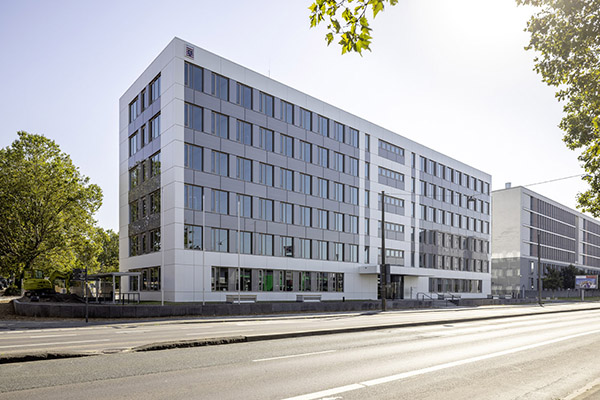
The "Platinum" — now regarded as a flagship project for sustainable public-sector office buildings — is the first timber-hybrid office building in Wiesbaden, Germany. It combines recyclable building materials with a sophisticated energy concept. The new building was designed as an energy-plus building and was awarded the German Sustainable Building Council's platinum pre-certificate.
All building materials used had to meet the highest sustainability standards. The glass elements made of Saint-Gobain COOL-LITE SKN 183 solar control glass were supplied by CLIMAplusSECURIT network partner Glas Herzog from Waghäusl. Swisspacer spacer bars ensure optimum energy efficiency in the glazing edge.
Use of recyclable materials
The architecture combines a CO2-saving timber hybrid construction method with recyclable building materials. The offices were furnished with natural and user-friendly surfaces.
With the timber-hybrid construction method, Neumann Architekten Frankfurt made full use of the structural strengths of timber, concrete and steel in the load-bearing structure. The planners were able to save more than 1,160 tons of CO2 equivalent thanks to this construction method.
A key aspect in the choice of building materials used was their recyclability. Wood, glass and aluminum are all building materials that can be reused when the building is dismantled at a later date or can be recycled in a new life cycle. The Platinum also assumes its role model function as a climate-neutral building during operation. This is ensured by an ice storage system for heating and cooling and 1,300 square meters of solar modules on the façade and roof. The system produces around 150,000 kilowatts of electricity per year, which is more than is needed to operate the office building. Innovative new developments in the field of photovoltaics were used on the façade, which produce solar power efficiently despite the light color of the modules.
Glass and glazing details
High demands were also placed on the glazing of the window elements. A high level of thermal comfort and the best daylight were requirement of the building. Another requirement for the triple solar control glazing was fall protection and sound insulation values of 46 and 41 decibels respectively. The external reflection was not allowed to exceed 14 percent.
CLIMAplusSECURIT partner Glas Herzog from Waghäusl opted for a design with COOL-LITE SKN 183 solar control glass in accordance with the catalog of requirements. The highly transparent glass ensured the best values for daylight yield. With its optimum solar control values and an energy transmittance of 36%, it will significantly minimize the cooling loads in the office building.
For the glass structure, COOL-LITE SKN 183 was combined with STADIP laminated safety glass for fall protection. STADIP SILENCE provides sound insulation and PLANITHERM XN thermal insulation. Swisspacer Advance spacer bar at the edge of the glass supports sustainable window and façade construction with its CO2 balance. In total, more than 1,000 square meters of glass elements were supplied.
What the company says
"We often have orders for large façade glazing, but this was the first time we used COOL-LITE SKN 183. Top thermal insulation, protective fall protection and efficient sound insulation; that's exactly what we want to sell," says Andreas Herzog, managing director, Glas Herzog GmbH. "It's a pleasure when you can use the high-quality glass with its top properties, especially in such an ambitious project."

